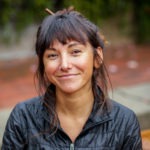Climate change is fueling extreme heat. Who’s looking out for the most vulnerable Americans?
Some cities and towns in the U.S. are enlisting volunteers, or a “cool buddy,” to check in on at-risk neighbors –including seniors, disabled people and those without air conditioning.
by Katie Rodriguez
Above: A roofer works in a housing development while the sun beats down on him during a June 2021 heat wave in Phoenix. Ross D. Franklin, AP
This story was published in USA TODAY on August 28, 2022.
In 2016, police found a 61-year-old Army veteran dead in his house after someone noticed his air conditioner was broken and his mail was piling up during a searing heat wave that broke records across Phoenix that June.
This summer in Houston, a 72-year-old woman was found unresponsive in her car as the temperature approached 100 degrees. She died at a local hospital of hyperthermia, or an abnormally high body temperature.
Every summer, heat records are being shattered in the United States, where heat waves, now increasingly common, claim more lives than any other natural disaster. And older people are disproportionately affected.
Across the country, buddy programs are cropping up to address the problem. In big cities such as Philadelphia and in rural communities such as Twentynine Palms in California, people are checking in on their older neighbors to make sure they have water, shade, fans or access to air conditioning and cooling centers.
In California, the state’s new Extreme Heat Action Plan calls for a widespread “cool buddy” program that would enlist volunteers to bring resources to the people most vulnerable to heat waves – including seniors, disabled people and those without air conditioning.
In a heat wave that hit Chicago in 1995, 73% of the 739 heat-related deaths were people older than 65, according to a 2002 book that chronicled one of the country’s deadliest heat spells. And over 80% of the estimated 12,000 Americans who die of heat-related causes annually are 60 or older, according to 2020 Climate Central study.
Research shows that building social capital, connections among people, is one of the most vital and overlooked ways to improve response and recovery during emergencies. That’s the rationale behind buddy programs.
Action Wellness in Philadelphia was one of the first official buddy programs in the country, launched in 1986 to support people living with chronic illnesses, most notably HIV and AIDS. The program also works with many seniors, identifying people in need by word of mouth or through a medical provider, and matching them either with a volunteer “buddy” or a case manager.
“If we’re going through a heat wave, the case managers identify who are the most vulnerable and make sure that they’re doing OK,” said Jay Johnson, director of volunteers for Action Wellness. “The case managers are aware of the cooling centers, and they will let their client know where the cooling centers are. They will help facilitate, if they need help, getting to the cooling center, whether that’s sending an Uber and Lyft to take them there or whatever mode of transportation is needed to get them there.”
Action Wellness has 120 clients in its buddy program, but even after three decades, funding and staffing remain an issue for the nonprofit, Johnson said.
California, meanwhile is investing $10 million in its Neighbor-to-Neighbor program over the next three years.
A state-led service agency called California Volunteers established a Neighbor-to-Neighbor program with the social networking service Nextdoor during the COVID-19 pandemic, to make sure vulnerable people had what they needed to shelter at home. That infrastructure now can be used for a variety of needs, including responding to extreme heat events and other climate emergencies.
Under its Extreme Heat Action Plan unveiled in April, California is hoping to tap Neighbor-to-Neighbor’s 5,000 volunteers to connect with vulnerable people before disaster strikes. The plan calls for mapping communities across the state, identifying those at risk for heat as well as neighbors who can help.
Similar volunteer groups have remained intact through the pandemic, leaving communities with structures for budding buddy programs.
Such networks are particularly important for seniors who may otherwise be isolated in heat emergencies. And as we age, we don’t adjust as well to temperature changes, said Linda Rudolph, director of the Center for Climate Change and Health at the nonprofit Public Health Institute.
“For elderly people who are low-income or people of color, these risks are cumulative,” she said. “Lower-income people are less likely to have air conditioning, or their air conditioning doesn’t function, or they don’t feel like they have the financial leeway to keep their air conditioners on because of electricity expenses. Those risks really compound any of these underlying individual risks.”
In the remote desert town of Twentynine Palms, volunteers with the nonprofit Reach Out routinely check in on senior residents, and the facility opens its cooling center to the whole community when the heat index reaches 115 degrees, which is common in the summer months.
Volunteer Erica Stone said neighbors who hadn’t acknowledged her in the past are “now giving me at least a little nod.” They recognize her as the person who drives around town in a dune buggy, checking on people – some daily – and doing grocery runs.
“This has not only been a very resourceful program to actually help us in case of an emergency, it’s actually united a lot of us in a very strange way,” she said. “For a social experiment, it’s been a great success.”
Katie Rodriguez is a writer with the Investigative Reporting Program at the University of California, Berkeley, Graduate School of Journalism. She reported this story through a grant from The SCAN Foundation. Email: katierodriguez@berkeley.edu.


